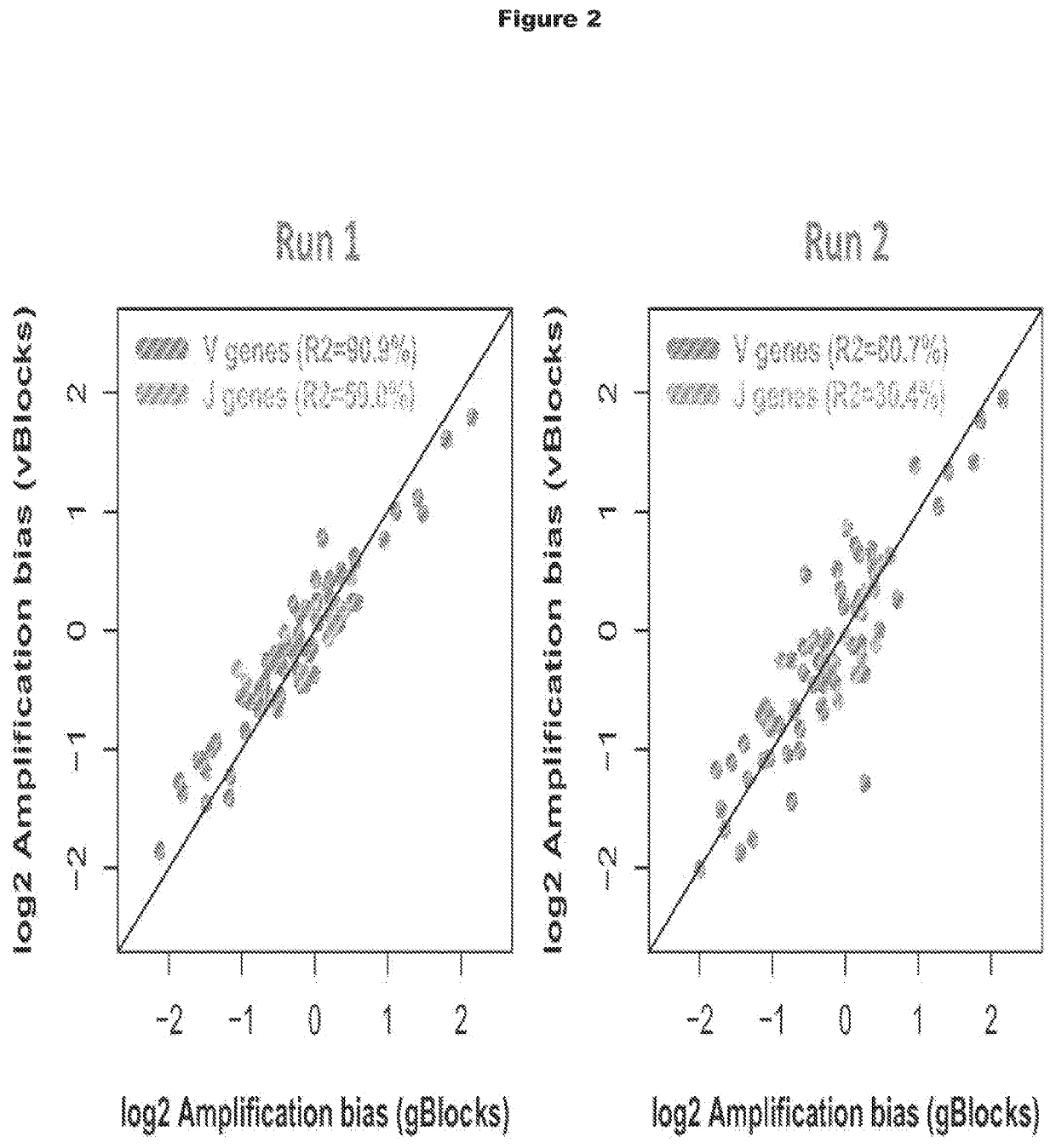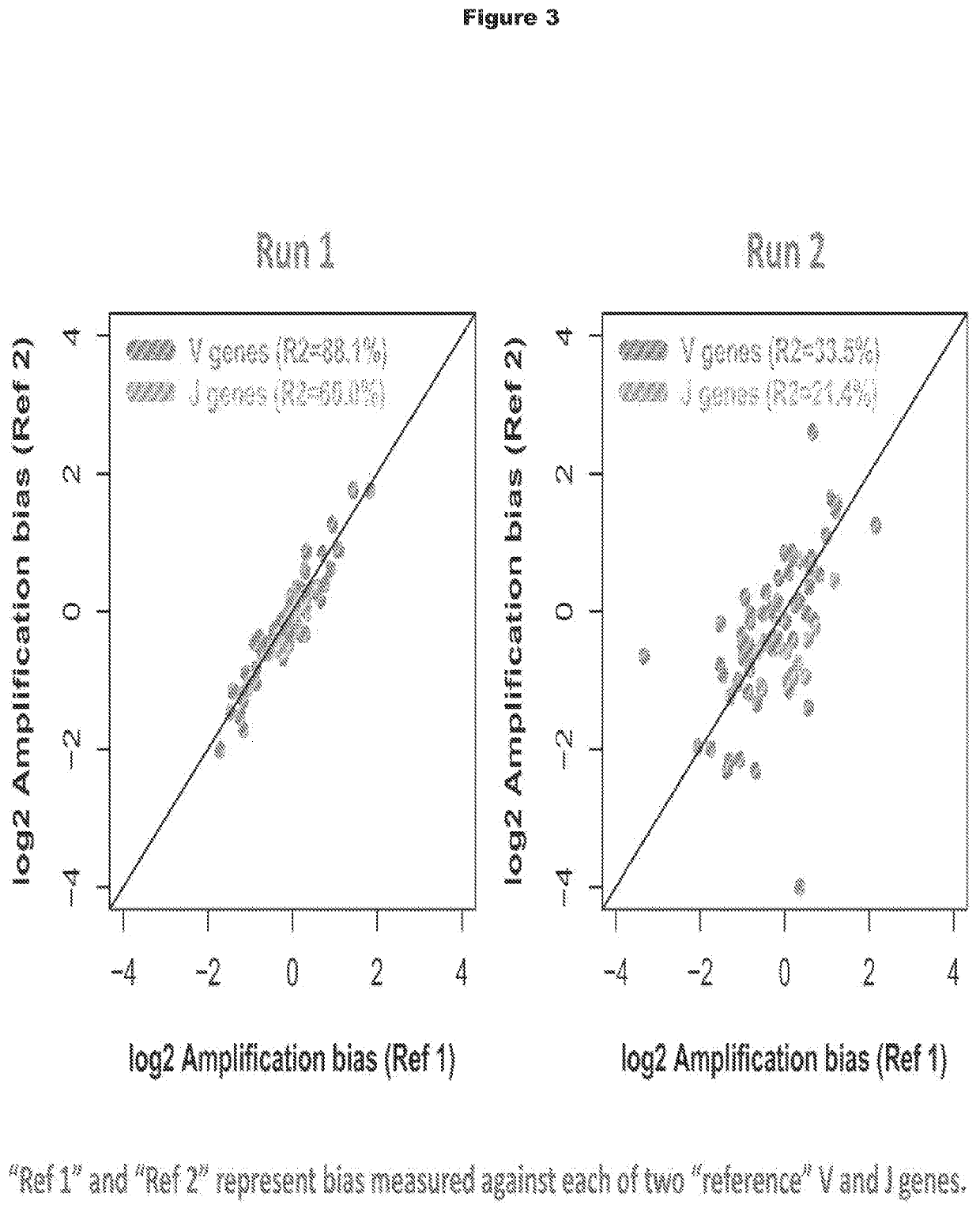Methods Using Randomer-Containing Synthetic Molecules
a synthetic molecule and randomer technology, applied in the field of randomer-containing synthetic molecules, can solve the problems of difficult to estimate the number of amplifiable genomes in a sample, cannot allow absolute quantitation of adaptive immune cells in the sample, and cannot always be trusted by value, so as to achieve excellent statistical information about amplification bias
- Summary
- Abstract
- Description
- Claims
- Application Information
AI Technical Summary
Benefits of technology
Problems solved by technology
Method used
Image
Examples
example 1
g Efficacy of Synthetic Sequences to Determine Normalization Factor in Correcting for Amplification Bias
[0339]Synthetic template molecules that include random oligonucleotide sequences (called “vBlocks” herein) were tested in methods for minimizing amplification bias and compared with synthetic template molecules that do not include random oligonucleotide sequences (called “gBlocks” herein). As shown in PCT / US2013 / 040221, the synthetic template molecules called gBlocks provide a benchmark for synthetic template molecules used for measuring and minimizing amplification bias of multiplex PCR primers.
[0340]vBlocks were designed and constructed as shown in FIGS. 1A and 1B. Each synthetic template may can be synthesized as 495 base pair oligonucleotides with the following structure (5′ to 3′): (1) a universal adaptor sequence (UA), (2) a 16 base pair barcode identifying V and J segments, (3) a V gene (about 300 base pairs), (4) a 9 base pair synthetic template internal marker (IM), (5) a...
example 2
ng Normalization Factors in Correcting for Amplification Bias in Amplification of Polynucleotides in Adaptive Immune Cells
[0345]vBlocks and rearranged biological molecules of CDR3 regions of T cells were amplified in multiplex PCR reactions and sequenced using the methods described above. The data from the vBlock sequence reads are extracted from the sequencing file and clustered together if they are determined to share the same randomer sequence. Two statistical passes were used to identify vBlocks. The first pass used the Hamming metric to compare read sequences versus vBlock sequences, wherein the randomer sequence was identified by recording the read sequence at the expected location of the randomer sequences in the best-matching vBlock sequence. The second pass was utilized for reads that did not find a good match by the Hamming metric. The Levenshtein metric was used in this instance, wherein the randomer sequence was identified by accounting for the locations of the indels in...
example 3
ng the Number of Input Genomes from a Sample of Adaptive Immune Cells
[0350]In this example, synthetic templates and genomic control genes were used to accurately calculate the relative representation of adaptive immune cells in a sample containing adaptive immune cells and non-adaptive immune cells.
[0351]Sample Source:
[0352]T cells were isolated from whole blood using standard cell biology techniques. DNA was extracted from the population of purified T cells. DNA was normalized, assuming 6.4 pg DNA / double stranded human genome such that approximately 5 genomes, 250 genomes, 1250 genomes, or 6250 genomes of T cell DNA were added to a standard TCRB PCR reaction.
[0353]Multiplex PCR Reaction:
[0354]TCRB Assay: Rearranged TCRB genes were amplified using a multiplex PCR. V segment and J segment primers were designed to amplify ˜110 bp rearranged fragments. Synthetic templates were added to each PCR reaction and were amplified with the same primers, and the synthetic templates included a ba...
PUM
| Property | Measurement | Unit |
|---|---|---|
| mass | aaaaa | aaaaa |
| mass | aaaaa | aaaaa |
| pH | aaaaa | aaaaa |
Abstract
Description
Claims
Application Information
 Login to View More
Login to View More - R&D
- Intellectual Property
- Life Sciences
- Materials
- Tech Scout
- Unparalleled Data Quality
- Higher Quality Content
- 60% Fewer Hallucinations
Browse by: Latest US Patents, China's latest patents, Technical Efficacy Thesaurus, Application Domain, Technology Topic, Popular Technical Reports.
© 2025 PatSnap. All rights reserved.Legal|Privacy policy|Modern Slavery Act Transparency Statement|Sitemap|About US| Contact US: help@patsnap.com



